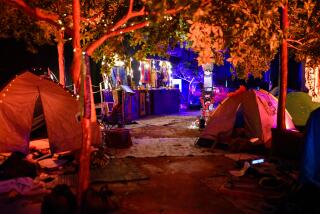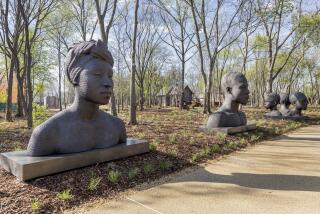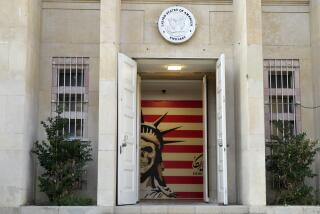Theme Park Tells of Hostage Crisis
- Share via
TEHRAN — A steel-fortified file cabinet ripped open by revolutionary students intent on bringing the United States to its knees. A dusty photograph of the White House inscribed with a message from President Carter “to the gang.” A carnival game that shoots tennis balls into the mouth of a devil who looks a lot like Uncle Sam.
Today, these artifacts--and surreal new creations--will go on public display for the first time at the former U.S. Embassy in Tehran, symbol of American imperialism to Iran and hostage-taking to the United States.
The idea, according to ultraconservative authorities who have turned the compound into a combination museum, amusement park and propaganda outlet, is to educate the people of the Islamic Republic, many of whom weren’t born when the 1979 hostage crisis was splashed across the world’s headlines.
On Thursday, a handful of journalists were the first foreigners invited inside the compound since the 52 U.S. hostages were freed in 1981 after 444 days of captivity.
For years, the compound served as a high school for the feared Islamic Revolutionary Guard. No one was allowed near the grounds, and taking photographs was absolutely forbidden. Visitors whizzing by in cars could only glimpse the crumbling American seal near the main gate, or the government-sanctioned graffiti such as “Death to America.”
The eagle is still crumbling, but the graffiti have been touched up. Taking pictures of the grounds is now welcomed, and festive red, green and white lights--the colors of the Iranian flag--beckon visitors inside.
Although relations with the United States have warmed under President Mohammad Khatami, the hard-liners in charge of the exhibit are aligned with Iranian supreme leader Ayatollah Ali Khamenei, who has denounced any attempts at detente.
“The last generation, they already knew about [American] interference with Iran, but this generation, they have to learn more about it and the history of our revolution,” said Mohammed Shoah, director of the Great Aban 13th exhibition, which refers to the Iranian date for the Nov. 4, 1979, embassy takeover.
For children, learning begins in the form of carnival games set up in a warehouse on the embassy grounds. Tired of using that air cannon to fire tennis balls at Uncle Sam? You can also punch America’s father figure. The Persian-language sign over a bop-it game in which contestants slam their fists onto Uncle Sam states: “Whatever Power You Have, Put It on the Head of America.”
For adults, there are more than 60 exhibits, including one with a trampled American flag and another demonstrating that American currency proves Israeli domination over the United States, at least according to a female tour guide. Take, for example, the 13 stars on the back of a $1 bill--upon closer examination, she says, they appear to form a Star of David. Or the bald eagle holding a shield that when upside-down appears to reveal a menorah, she explains through the opening of her tightly pinched black chador.
Most of the story of American imperialism that Shoah and others hope to impart, however, is told through photographs. There are dozens depicting the consequences of U.S. military attacks, from the Vietnam War to the current bombing of Afghanistan.
The most graphic, perhaps, are pictures of dead children retrieved from the floating wreckage of the Iranian Airbus mistakenly blown out of the skies by the U.S. warship Vincennes in 1988.
And if visual examples don’t suffice, there are plenty of signs in Persian and English to guide the visitor. The latter are somewhat incoherent, such as “The world Muslims can neutrelize the airojance plots.”
“Iranians don’t have that much familiarity with English,” translator Zavin Kamar says when asked about the mistakes.
The kitsch and carnival atmosphere are left outside the three-story embassy. Inside, visitors are greeted by the smell of fresh lime paint. The main floor has been stripped of much of the original furniture, and no one was allowed into the basement where the hostages were kept.
(Shoah insisted through a translator that no hostages tracked time by carving into the walls, and he described their living conditions as luxurious.)
Upstairs, however, signs of the Americans’ lives before that November day 22 years ago are evident. Aging Teletype machines and shredders stand silent in vaults. Faded yearbook pictures of teenagers with 1970s hairstyles and polyester clothes lie on a table nearby.
Mannequins of Ambassador William Sullivan and key aides are on display in a soundproof office with glass walls a half-foot thick.
Nothing has been moved from where the Americans left things when Iranian students climbed over the embassy wall, the guides say. A few black-and-white photographs of those moments are part of the exhibit. So is a copper-colored statue of a Marine, his hands held high in surrender.
Chilling reminders of the failed U.S. attempt to rescue the hostages are also on display: the rusty rotors of a Sea Stallion helicopter, one of which crashed into a C-130 in the failed operation in April 1980.
Notably absent at the opening ceremonies Thursday were the actual hostage-takers. Most of them are now liberal reformists holding key positions in the Islamic Republic.
They were invited, Shoah said, and are expected to take part in round-table discussions to be held in the former ambassador’s office in the future.
Also absent were the former hostages.
Malcolm K. Kalp was a commercial attache at the embassy when it was seized. Kalp, who is retired and lives in a Boston suburb, said the museum is pure propaganda.
“I wouldn’t expect any balance. What else is new? They’re still talking about American imperialism. They’ll never change.”
*
Times staff writer Miles Corwin in Los Angeles contributed to this report.
More to Read
Sign up for Essential California
The most important California stories and recommendations in your inbox every morning.
You may occasionally receive promotional content from the Los Angeles Times.










